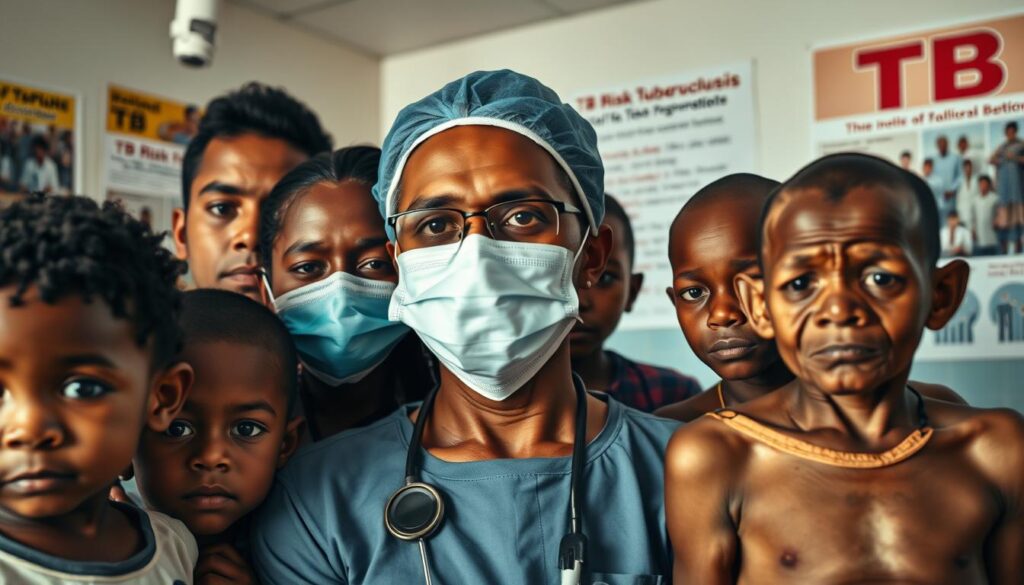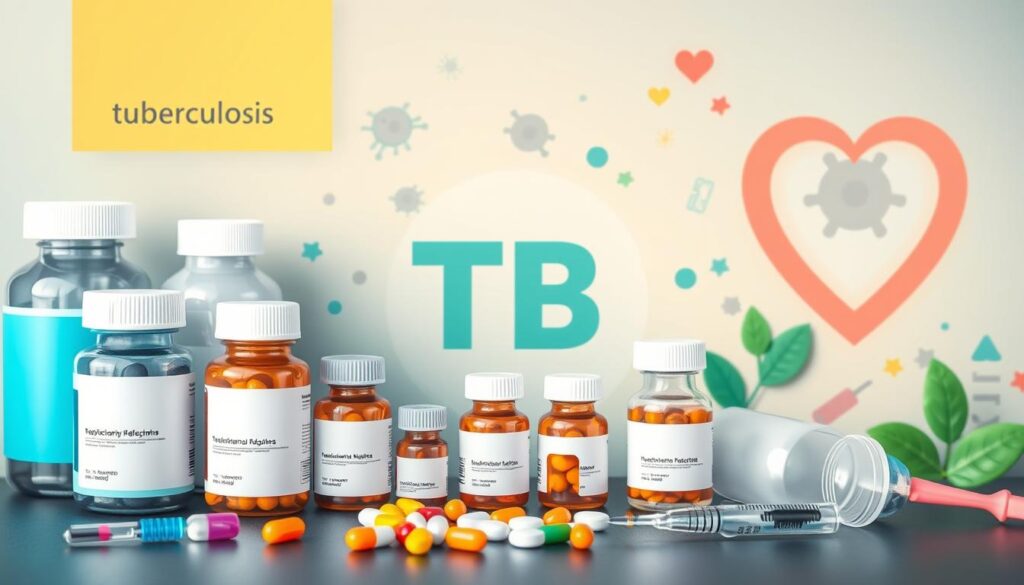Tuberculosis, or TB disease, is a serious infection caused by mycobacterium tuberculosis bacteria. It’s a complex lung infection that can spread silently. This affects millions of people worldwide.
The TB disease mainly attacks lung tissues but can also harm other organs. Signs include persistent cough, unexplained weight loss, and chronic fatigue. Doctors stress the importance of catching it early to treat it effectively and stop it from spreading.
Key Takeaways
- TB is a highly infectious bacterial disease targeting lung tissues
- Early detection significantly improves treatment outcomes
- Mycobacterium tuberculosis can spread through respiratory droplets
- Some populations have higher susceptibility to TB infections
- Comprehensive medical screening is crucial for diagnosis
Understanding Tuberculosis (TB): An Overview
Tuberculosis is a big health problem worldwide, affecting millions. It’s a complex disease with big public health issues. Knowing how it spreads and its types is key to stopping and treating it.
The world is still fighting against this infectious disease. TB comes in two main types: latent TB infection and active TB disease. Each type has its own challenges for doctors and patients.
The Global Impact of TB
TB affects countries all over, with some places having more cases than others. Important numbers show how widespread the disease is:
- Every year, about 10 million people get active TB.
- 1.5 million people die from TB each year.
- Most cases are in developing countries.
How TB Spreads in Communities
Airborne transmission is key in TB spread. When someone with active TB coughs or sneezes, they release tiny droplets. These droplets can carry the bacteria and infect others nearby.
| Transmission Method | Risk Level | Prevention Strategies |
|---|---|---|
| Respiratory Droplets | High | Mask wearing, ventilation |
| Close Personal Contact | Moderate | Social distancing, screening |
Types of Tuberculosis Infections
TB comes in two main types, each with its own treatment:
- Latent TB Infection: Bacteria are present but not active, with no symptoms.
- Active TB Disease: Bacteria are growing and causing symptoms.
“Understanding the difference between latent and active TB is crucial for effective management and prevention” – World Health Organization
Doctors stress the importance of early detection and treatment. This helps stop TB from spreading and keeps communities healthy.
Common Signs and Symptoms of TB Disease
Tuberculosis (TB) has distinct symptoms that can harm your health. It’s key to spot these signs early for the best treatment and to stop the disease from spreading.
The main TB symptom is a persistent cough that lasts over three weeks. This cough might hurt your chest and could have blood or look different, showing lung infection.
“Early detection of TB symptoms can make a critical difference in treatment outcomes and patient recovery.” – Global Health Organization
- Persistent cough lasting more than 3 weeks
- Unexplained weight loss
- Night sweats
- Extreme fatigue
- Fever and chills
People with night sweats say they’re very wet, soaking their clothes and bedding. Weight loss can be huge, with people losing a lot of weight without trying to.
| Symptom | Typical Characteristics | Potential Severity |
|---|---|---|
| Persistent Cough | Lasting over 3 weeks | High risk of lung damage |
| Fatigue | Extreme exhaustion | Indicates immune system strain |
| Night Sweats | Profuse sweating during sleep | Potential infection indicator |
| Weight Loss | Unintentional body mass reduction | Suggests metabolic disruption |
Fatigue from TB can be very hard, making it hard to do everyday things. Doctors say seeing a doctor right away is important to get diagnosed and start treatment.
How TB Affects Different Parts of the Body
Tuberculosis is a complex disease that can impact multiple body systems beyond the lungs. Understanding how pulmonary tuberculosis and extrapulmonary TB interact with human anatomy provides crucial insights into its devastating potential.
The bacterial infection caused by Mycobacterium tuberculosis can spread throughout the body, creating unique challenges for patients and healthcare professionals.
Pulmonary TB Manifestations
Pulmonary tuberculosis mainly attacks the lungs, causing significant respiratory complications. Key symptoms include:
- Persistent coughing lasting more than three weeks
- Chest pain and difficulty breathing
- Frequent lung infections
- Potential lung tissue damage
Extrapulmonary TB Complications
When TB spreads beyond the lungs, it can affect various organs with potentially serious consequences:
| Organ System | Potential TB Complications |
|---|---|
| Lymph Nodes | Swelling and inflammation |
| Skeletal System | Bone and joint infections |
| Nervous System | Meningitis and neurological disorders |
| Kidney | Urinary tract infections |
TB Effects on the Immune System
The immune system response to tuberculosis is complex. TB bacteria can manipulate the body’s defense mechanisms, creating a sophisticated survival strategy that challenges traditional immune reactions.
“TB is a master of immune evasion, capable of hiding and reproducing within human cells.” – Infectious Disease Research Center
The bacteria trigger inflammatory responses while simultaneously suppressing the immune system’s ability to eliminate the infection completely.
Risk Factors and High-Risk Populations

Tuberculosis (TB) doesn’t affect everyone the same way. Some groups face a much higher risk of getting TB. This is because of their health and living conditions.
Knowing who is at risk helps us focus on protecting them. We can then create plans to stop TB before it starts. Some groups at higher risk include:
- Individuals with HIV/AIDS
- People living in overcrowded living conditions
- Individuals with weakened immune systems
- Healthcare workers
- Substance abuse patients
“Knowledge of risk factors is the first step in preventing TB transmission and protecting vulnerable populations.” – World Health Organization
People with weak immune systems are very likely to get TB. HIV/AIDS patients are at a much higher risk. This is because their bodies can’t fight off the infection well.
| Risk Group | TB Infection Probability | Primary Factors |
|---|---|---|
| HIV/AIDS Patients | 30-50 times higher | Compromised immunity |
| Homeless Populations | 10-15 times higher | Overcrowded living conditions |
| Chronic Disease Patients | 5-10 times higher | Weakened immune system |
It’s important to screen these groups often and act early. Doctors say regular check-ups and quick action are key to managing TB risk.
Modern Diagnostic Methods for TB Detection
Finding tuberculosis (TB) early is key to treating it well and stopping it from spreading. Doctors use many ways to find TB, mixing different tests to make sure they get it right.
Today, finding TB uses new, advanced tests. These tests give doctors clear information about infections. This helps them make the best choices for their patients.
Skin Tests and Blood Tests
There are two main ways to screen for TB:
- Tuberculin skin test (TST): A classic tool that spots TB infection
- Interferon-Gamma Release Assays (IGRA): A blood test that finds TB’s immune response
Imaging Techniques
Chest X-rays are still very important for finding TB. They let doctors see lung problems and signs of TB.
Laboratory Analysis Methods
Lab tests are a big part of finding TB:
- Sputum culture: Checks mucus for TB bacteria
- Microscopic examination: Looks for bacteria
- Molecular testing: Finds TB fast and accurately
“Early detection is the key to successful TB management and prevention.” – World Health Organization
Each test has its own benefits. They help doctors create plans that fit each patient’s needs if they might have TB.
Treatment Options and Medication Protocols
Tuberculosis (TB) treatment needs a mix of antibiotics to fight the infection. The usual treatment plan includes a set of medicines. This helps patients get better and stops the bacteria from becoming resistant to drugs.

The main TB treatment strategy uses strong antibiotics. The key drugs are:
- Isoniazid – a powerful first-line drug
- Rifampin – another key antibiotic
- Ethambutol
- Pyrazinamide
“Successful TB treatment depends on strict adherence to the prescribed medication regimen.” – World Health Organization
The DOTS strategy is key in TB treatment. It makes sure patients take all their antibiotics as directed. This strategy stops drug resistance and ensures treatment works well.
Typical TB treatment has two parts:
- Intensive Phase: 2 months of many antibiotics
- Continuation Phase: 4-7 months of specific medication
Doctors watch patients closely during treatment. They change medications if needed for the best results. It’s very important to finish all antibiotics to avoid drug-resistant TB.
Drug-Resistant TB: Challenges and Solutions
Drug-resistant tuberculosis is a big problem worldwide. It makes treating TB harder. Doctors now have to use new ways to fight MDR-TB and XDR-TB.
Drug-resistant TB strains are hard to control. Patients with MDR-TB need special tests to find the right treatment.
Understanding Multiple Drug Resistance
MDR-TB happens when TB drugs don’t work anymore. It’s marked by:
- Resistance to primary TB drugs
- More complex treatment plans
- Higher chance of treatment failure
- Longer treatment times
Treatment Strategies for Resistant Strains
Dealing with drug-resistant TB needs special drugs and care. Doctors make treatment plans based on lab tests.
| TB Resistance Type | Treatment Complexity | Duration of Treatment |
|---|---|---|
| MDR-TB | High | 18-24 months |
| XDR-TB | Extremely High | 24-36 months |
Prevention of Drug Resistance
Stopping drug resistance needs careful treatment and teaching patients. Doctors stress taking all medicine and regular check-ups.
“Combating drug-resistant TB demands a multifaceted approach combining medical expertise, patient compliance, and advanced diagnostic techniques.” – Global TB Research Network
Beating drug-resistant TB needs teamwork. Healthcare workers, researchers, and patients must work together. This way, we can find better treatments and stop more resistance.
Prevention Strategies and Vaccination
Tuberculosis (TB) prevention needs a wide approach. It targets many areas of infection control. Good strategies aim to stop TB spread and protect those at risk through early action.
- BCG vaccine administration for high-risk populations
- Implementing rigorous infection control measures
- Conducting systematic contact tracing
- Regular screening programs
“Prevention is always better than cure, specially with infectious diseases like tuberculosis.” – Dr. Maria Rodriguez, Infectious Disease Specialist
The BCG vaccine is key in TB prevention, mainly in areas with lots of TB. It helps keep kids and people with weak immune systems safe from serious TB.
| Prevention Strategy | Target Population | Effectiveness |
|---|---|---|
| BCG Vaccination | Children in high-risk areas | 60-80% protection |
| Contact Tracing | Exposed individuals | Early detection |
| Infection Control Measures | Healthcare settings | Reduces transmission risk |
Contact tracing is vital in TB prevention. It finds and checks people who might have been near someone with TB. Doctors use advanced tracking to stop TB from spreading.
In healthcare, infection control is crucial. It includes good air flow, wearing protective gear, and strict TB patient isolation. These steps greatly lower TB spread in hospitals.
Living with TB: Lifestyle Adjustments and Support
Living with tuberculosis means more than just treatment. It’s about caring for the whole person. This includes physical, nutritional, and mental health support.
Recovering from TB is all about wellness. The right mix of nutrition, exercise, and mental health care is key. It helps improve treatment results and life quality.
Diet and Nutrition Guidelines
Nutrition is key in TB recovery. A balanced diet boosts the immune system and helps regain strength:
- Eat high-protein foods like lean meats, eggs, and legumes
- Add vitamin-rich fruits and vegetables
- Drink plenty of clean water
- Follow nutritional supplements as advised by doctors
“Food is medicine for TB patients. The right nutrition can dramatically improve recovery rates.” – TB Research Institute
Physical Activity Recommendations
Light exercise helps in TB recovery. It’s important to:
- Begin with gentle walking
- Do breathing exercises
- Slowly increase activity
- Talk to doctors about safe exercises
Mental Health Support
Psychological counseling is crucial for TB patients. The emotional side of treatment is big, so mental health support is vital:
- Get professional counseling
- Join support groups
- Try stress-reduction methods
- Talk openly with healthcare providers
Remember, TB recovery is a journey that heals both body and mind.
TB in Special Populations: Children and Elderly
Tuberculosis is a big challenge for certain groups. This includes kids and older adults. They need special care when it comes to finding and treating TB.
Children are more likely to get TB because their immune systems are still growing. Pediatric TB can be hard to spot because it looks like other common kids’ illnesses. Kids might show signs like:
- Persistent cough
- Unexplained weight loss
- Reduced energy levels
- Difficulty breathing
“Early detection is critical in managing TB among children and preventing further spread,” says Dr. Emily Rodriguez, pediatric infectious disease specialist.
Older adults face their own set of problems with TB. Immunocompromised patients in this age group are at a higher risk of serious TB. Their immune systems are weaker, making it harder to diagnose and treat TB.
There are special things to think about when TB happens during pregnancy. This includes:
- Careful medication selection
- Close monitoring of maternal and fetal health
- Specialized treatment protocols
- Potential risks to both mother and unborn child
Doctors need to create special plans for treating TB in these groups. This ensures they get the best care possible.
Latest Research and Future Treatment Developments
TB research is making big strides with new ways to find and treat the disease. Scientists at top institutions are using precision medicine to change how we fight tuberculosis. New drugs are coming from clinical trials, aiming to beat bacterial resistance and infection.
The Gates Foundation and World Health Organization are backing TB vaccine development worldwide. Researchers are working on vaccines that protect against many tuberculosis strains. New technologies help scientists understand bacterial changes, leading to faster, more effective treatments.
New diagnostic tools are changing how we find TB. Advanced molecular screening and AI help doctors spot infections quickly and accurately. These tools are key in areas with little medical help, where fast diagnosis can save lives.
Global health efforts are focusing on personalized TB treatment. By looking at genetic profiles and bacterial traits, researchers aim to create treatments that work best for each person. The fight against TB is getting stronger, with teams working together to prevent and cure the disease.


